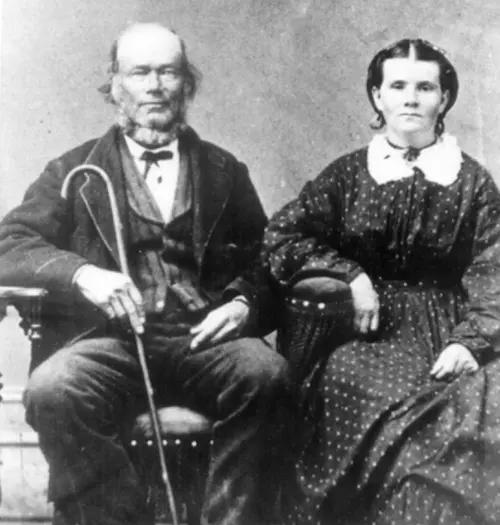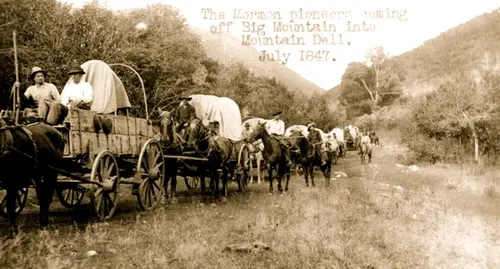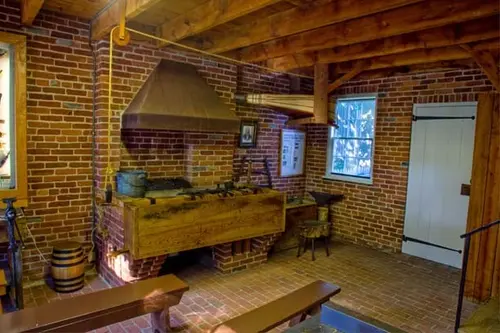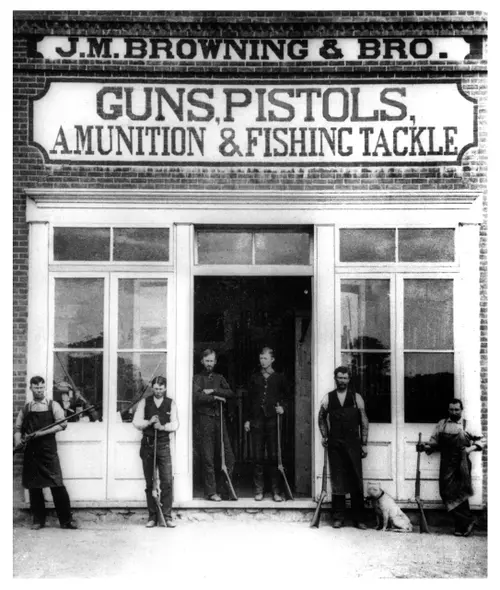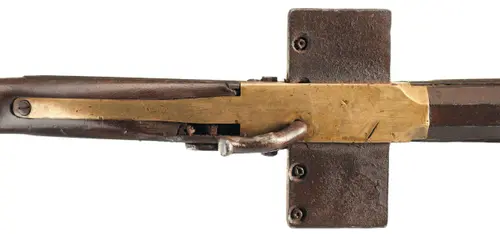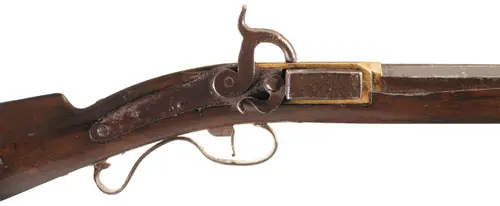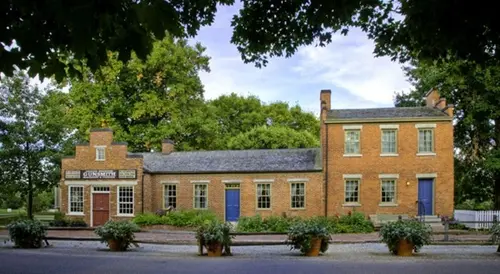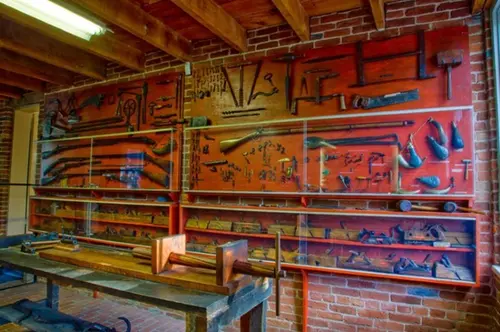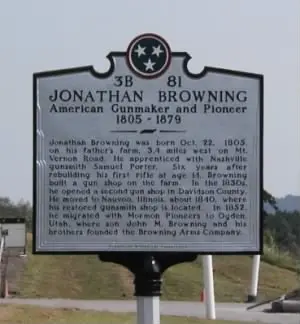In Honor of the Parents of "the Father of Modern Firearms."
Thank you Jonathan and Elizabeth Browning.
To those of us who enjoy firearms and firearms history, the story of the Browning company's founder, John Moses Browning is generally known. His ingenuity at improving existing concepts was unequaled and his totally-new firearms inventions are legendary. He began life in Utah before the transcontinental railroad and died in Belgium after approximately 61 trips to Europe and countless trips to New England's "Gun Valley. "
But through it all, we rarely talk about the impact that John Browning's father and mother had on his future success. To put in mildly, it was a HUGE impact. Not as much is known about his mother, Elizabeth Caroline Clark Browning, but we assume her impact was extremely significant. However, a great deal is known about his father, Jonathan Browning. Jonathan was a remarkable man in every way. He was, as we would say now, "a gun guy." His inventions and innovations were significant -- but remain largely overshadowed by his son's.
It is important to note that he was also one of the "Mormon Pioneers," of the mid-1800s . . . part of a movement that settled the Great Basin of Utah and surrounding states. After fulfilling an assignment from Brigham Young to outfit wagon trains of Mormon pioneers with guns and gear for several years, he came to Utah and established himself as a gunsmith and businessman extraordinaire in Ogden, Utah, setting the stage for the future success of his son, John Moses Browning.
Jonathan is shown in the photo with the woman originally believed to be his wife Elizabeth Caroline Clark, John Moses Browning's mother. However, many in the Browning family now believe this is actually Jonathan's daughter Asenath. Unfortunately, there is no verified photo of John Browning's mother Elizabeth.
Jonathan poses with a woman who is likely his daughter Asenath. Originally this photo was thought to be of Jonathan and Elizabeth, his wife. Details on why this is now disputed are contained at the bottom of this article.
Jonathan Browning stayed behind in 1847 at Council Bluffs, Iowa, to outfit Mormon pioneer wagon trains as they left for Utah. He finally came to Utah in 1852.
The Nauvoo Years. Where do you go to learn about this great, but largely unknown man? One good place is to visit is the Jonathan Browning Gunshop and home in Nauvoo, Illinois (see photo). The original gunshop he built has been completely restored and is open for tours without charge. It was in this solid brick building that he first came to expand his experiments in advanced gun concepts and manufacturing principles that would lay the groundwork for his son's future designs.
Jonathan was born in Tennessee in 1805 at the same time Lewis and Clark were exploring the Louisiana Purchase. As a teenager, he apprenticed as a gunsmith, started his own shop and was building a successful business. After joining the Church of Jesus Christ of Latter-Day Saints (often referred to as the Mormons) he moved with them to Illinois where he built his shop and functioned as the main gunsmith in the Nauvoo area.
On display in the restored home and gunshop are several of his guns (along with a number of John Browning's guns). He invented a sliding breech repeating rifle often called a "slide gun" or a "harmonica gun" sometime between 1834 and 1842 while living near Quincy, Illinois (he probably lived in La Prairie). These rifles were the precursors to today's high-capacity magazine firearms. With a solid block of metal to hold multiple loads, they were a bit heavy for sure. But he proved the concept which would later become the modern magazine. His business success in Quincy lead to his high regard in the community and soon he was elected as the justice of the peace. During this time he met a young lawyer by the name of Abraham Lincoln who reportedly was an overnight guest in his home at least two times.
He moved from Quincy to Nauvoo primarily to be closer to the gathering place of the Mormons and continued building and repairing guns in Nauvoo. This continued until persecution drove the Mormons out of Illinois -- which began the Great Mormon Migration to what would eventually become Utah.
Inside the Jonathan Browning home in Nauvoo, Illinois.
He was devout about his religion and his firearms. Guns made by him during this time were each marked with the words "Holiness to the Lord - Our Preservation."
Jonathan did not cross the plains with the early groups of pioneers but stayed behind in the temporary city of Kanesville (Council Bluffs) at the request of Brigham Young. This assignment was to outfit and equip the pioneers as they headed west over the next few years. In 1852 Brigham Young called him to Utah where he settled in Ogden, just north of Salt Lake City. Today it's about a 15-minute drive from Ogden to Browning's headquarters in Morgan.
As you will read in the story below, Jonathan lead a very successful life in Ogden as a businessman, a gunsmith and in public service. He was a family man at his core and he prepared the way for the success of his children. His son, John Moses Browning worked at his gunshop and store from an early age. And it was there, in 1878, under his father's supervision that John Moses Browning invented his first rifle: The Browning Single Shot. It later became known as the Winchester 1885 or the B-78. The Winchester 1885 is still in production today. Just a year after his son invented the Single Shot Jonathan Browning passed away in Ogden, Utah. And the rest, as they say, is history.
This short overview of Jonathan below is edited from an original historical document from 1932. We hope you enjoy it.
The Browning Brothers Store in Ogden, Utah. John Browning and his crew, several holding his Single Shot Rifle.
The photo is a top view of Jonathan Browning's so-called "harmonica" rifle serial number two. It represents one of the earliest designs in the world incorporating a detachable magazine. At the time of its development metallic cartridges were in their infancy. Otherwise, Jonathan might have envisioned a lighter weight solution.
The top view photo shows the "magazine" inserted into the side of the receiver with hammer down. More images and information are available on the Rock Island Auction Company website.
Top view of a rifle that is most likely the work of Jonathan Browning. Photo courtesy Rock Island Auction Company.
Side view of the same rifle. Image courtesy of the Rock Island Auction Company.
Above is the Jonathan Browning gun shop as it is today in Nauvoo, Illinois.
This wall display includes period tools and jigs that Jonathan Browning would have used in his manufacturing and repair of firearms. Most interesting is the wooden rifling jig in the foreground.
A roadside plaque was created in Jonathan's memory. The plaque is located near his birthplace in Tennesse. It reads:
Jonathan Browning was born Oct. 22, 1805, on his father’s farm, 3.5 miles west on Mt. Vernon Road. He apprenticed with Nashville gunsmith Samual Porter. Six years after rebuilding his first rifle at age 14, Browning built a gun shop on the farm. In the 1830s he opened a second gun shop in Davidson County. He moved to Nauvoo, Illinois about 1840, where his restored gunsmith shop is located. In 1852 he migrated with Mormon Pioneers to Ogden, Utah, where son John M. Browning and his brothers founded the Browning Arms Company.
Roadside marker in Tennessee.
JONATHAN BROWNING was the son of Edmund and Sarah Allen and was born October 22, 1805, at Brushby Fork of Bledsoe Creek, near Nashville, Sumner County, Tennessee. In his youth, he was steady, thoughtful and devoted to the acquisition of useful knowledge. He married his first wife, Elizabeth Stalcup, November 9, 1826, and there were twelve children born to them, as follows: Sarah A, David E., Barbara J., John W., James A., Asenath E., Martha C., Mary M., Nancy L., Emma E., Jonathan A. and Melinda V.
In 1834 he moved with his family from Tennessee, locating in Adams County, Illinois, where he invested largely in land and carried on agricultural pursuits in connection with his trade, gun, and blacksmith. In 1842 he moved to Nauvoo, he having previously been converted to Mormonism. Here he built a nice two-story brick residence, gunsmith shop, etc., on Main Street, which he subsequently left without a cent's remuneration, emigrating west, in 1846 [along with] the general Mormon exodus from Nauvoo.
He settled and remained in Western Iowa, near Council Bluffs (then called Kanesville) on the Missouri bottoms, close to the little village (of Indian traders) called Sarpy's Point. Here he engaged in manufacturing guns, wagons, etc., making several improvements and inventions in firearms. He also carried on farming and discharged the duties of a magistrate, which office he had previously held in the states he had left.
Many years after his demise an old gentleman from Idaho sent his family a copy of the Frontier Guardian, published in Kanesville, Iowa, September 19, 1849, in which was the following advertisement:
"GUNSMITHING. The subscriber is prepared to manufacture, to order, improved Fire-arms, viz: revolving rifles and pistols; also slide guns, from 5 to 25 shooters. All on an improved plan and he thinks not equaled this far east. (Farther west they might be.) The emigrating and sporting community are invited to call and examine Browning's improved fire-arms before purchasing elsewhere. Shop eight miles south of Kanesville on Mosquito Creek, half a mile south of Trading Point. JONATHAN BROWNING."
In 1852 he resumed his journey, crossing the plains, of three months' travel, by ox teams. He was captain of a company in crossing the plains and being an expert marksman, he frequently furnished the camp with meat from the vast quantities of buffalo along their route of travel.
Arriving in Utah, October 2, 1858, Jonathan Browning settled in Ogden, where he continued to reside until the time of his demise.
On March 17, 1854, he married Elizabeth C. Clark, and there were born to them three children, viz.: Elizabeth C., John M. and Matthew S.
On March 29, 1858, he married Ann Emmett and there were born to them seven children, viz.: Jonathan E., T. Samuel, William W., Olive A., George E., Benjamin F. and Susan 0.
In the history of Ogden City, he is recorded as one of its founders and principal business men and property owners. Much of the real estate on the principal business street now known as Washington Avenue, once belonged to Jonathan Browning. He owned four city lots on the west side of this street, beginning at what is now known as the Eccles Building, and running south to where the Egyptian Theater now stands, and where some of the finest buildings of the city have since been erected.
During his residence in Ogden City, he held many civil and ecclesiastical offices. He also, at an early age in manhood, before he gathered with the Mormon people, was a representative man in society, he having been a justice of the peace in Sumner County, Tennessee. Soon after his arrival in Ogden, he was elected a member of the Ogden City Council. He also held the various positions of justice of the peace, probate judge of Weber County, and member of the Legislature of Utah.
In the ecclesiastical sphere, he was a bishop's counselor, member of the High Council, and president of the High Priests Quorum. In all his official capacities Jonathan Browning proved himself to be a man of honor, truth, and integrity. As one of the founders of the city, he did much in developing its resources and business. He had a gun and blacksmith shop, where he made fine guns and made the first iron-roller molasses mill in Ogden. He made plows and all mill irons for sawmills, flour mills, etc., and erected a tannery, grinding the bark and tanning the hides, and also had a factory for making boots and shoes. He manufactured nails and many other articles that could not be brought from the Missouri River by teams. He did as much or more than any other man for the upbuilding and improving of Ogden City and Weber County.
In the family of the Brownings, there seems to be a large vein of native talent. Edmund Browning, the father of Jonathan was a fine musician in his day (a violinist), and Jonathan was a cousin of the late Hon. Orville H. Browning, the famous lawyer of Quincy, Illinois, and ex-secretary of the interior, and he was also a cousin of Doctor Browning, of Nashville, Tennessee. He was a descendant of Capt. John Browning, born in England about 1588. He came to America in the Abigail in 1622, having sailed from Gravesend, England, and landed on College Lands in Virginia, near the mouth of the James River, in what was afterward Jamestown, York County, Virginia.
In fine, Jonathan Browning was very respectably connected in Illinois, as well as Tennessee, and was, himself, all his lifetime, called Squire or Judge. He was a prominent man among his fellow citizens; universally respected and an untiring advocate of temperance; unswerving and true to his convictions as the needle to the pole; he was one of God's noblemen - a truly honest man. He died at Ogden City June 21, 1879. He passed away in peace, surrounded by his large and devoted family, on whom he left his blessing and final farewell, in the seventy-fourth year of his age.
Abridged from: BIOGRAPHY: Jonathan Browning; Ogden, Weber Co., Utah / History of Utah -- The Storied Domain / A Documentary History of Utah's Eventual Career by J. Cecil Alter / Vol. 2, published 1932 (expired copyright) / The American Historical Society, Inc.
To read the story above at its original location click this address: http://files.usgwarchives.net/ut/state/bios/alter/b/browning-jonathan.txt
View a slide show of the Jonathan Browning gunshop museam as it is restored today (courtesy the LDS Church) by clicking here. Several images above are from the slides.
There is a nice overview of Johathan Browning on Wikipedia. Just click here.
Special thanks to Deven Browning for assistance with this article. Deven is an employee at the Browning headquarters in Morgan, Utah in Browning's Information Technology department and is a descendant of Jonathan Browning -- Read more about the early years of Jonathan Browning on the Jonathan Browning Organization website.
Deven Browning offers some insights into the complexity of the Jonathan Browning family tree. The article contains several things that are commonly published about Jonathan but are in question along with other confusing family names.
- We are quite certain that he never lived in Quincy. He lived in La Prairie before Nauvoo but not in Quincy. La Prairie is about 25 miles NE of Quincy. He transacted business in Quincy but never lived there.
- Also we have not been able to prove that he descends from Captain John Browning. It makes good press and it may be true but it is not proven.
- Jonathan had a brother named John.
- Not only that, he had four sons that had Jonathan or John as their first name. He also had a sister and a daughter both by the name of Clarissa.
- In addition, he had two wives and a daughter by the name of Elizabeth. And three other daughters that had Elizabeth or Eliza in their names.
- His first wife Elizabeth went by Betsy after they settled in Utah and he married his second wife, also named Elizabeth – probably to help avoid some of the confusion.
Born in 1855, John M. Browning dedicated his life to inventing revolutionary firearms that were destined to shape the future. Read about him in this riveting biography. Click Here to learn more.



